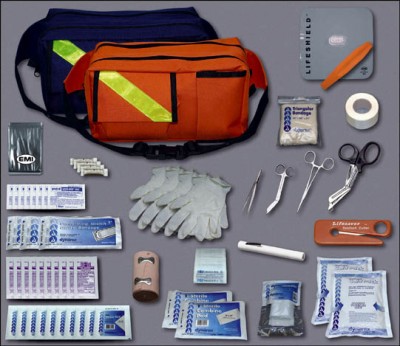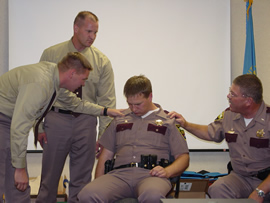Your day always starts the same way. You punch in and wander outside to find the ambulance that’s going to be your home, office, break room, and personal teleporter for the next 8 (or 48) hours. Then you crack it open and figure out if it’s capable of surviving that journey.
The checkout is an integral part of your shift, and it’s not rocket science. It’s simply a process of ensuring that the equipment you’re going to need is available and functional, that you know where it is, and that anything needed is restocked or repaired before… well, before you need the darned thing.
You can go through this in a wide variety of ways, and the best process for you will depend on vagaries like how your rigs are set up, what equipment you carry, and even what’s written on your physical checklist, if you have one. But here are some general tips for optimizing things.
Start with the most critical items. That means equipment that’s essential and lifesaving, such as the AED; it also means equipment whose absence can’t be substituted, worked around, or otherwise managed. For instance, 4x4s are important — direct pressure saves lives — but there’s a dozen other types of dressings you probably have floating around, so they’re not truly essential. What’s essential?
The ambulance. If you can’t transport people, you are out of service; you are worse than useless. The first thing I do is crank the engine and make sure it catches, check for warning lights, and eyeball the fuel. If required by your service, check fluids, kick tires, whatever’s needed.
Your signal and warning devices. This is a safety issue for you and your patients. While you’re up front checking the engine, flip the lights on and check that they’re all blinking. Then key the PA microphone, listening for the audible pop (or scratch it with a nail if it’s not easily audible). If the PA works, the siren generally works, since they often use the same speakers. (Actually flipping on the siren tends to be deafening and obnoxious to everyone in earshot, so I avoid it unless the PA itself is broken.)
Next up should probably be your AED. This not only brings the dead back to life, it’s the only way of doing so unless you’re going to jerry-rig something from the truck battery and jumper cables, or try the ol’ precordial thump and prayer. Different AEDs have different maintenance procedures; most perform their own internal checks once a day at least, and you can just look for the “all’s well” symbol on the display (usually a check mark). In other cases, you’ll need to key the thing on to make sure it’s working. Check that your pads are within date (the conductive gel inside eventually dries out — this is also why the packaging should remain sealed during storage), and if it’s a model that lets you preload the wires without opening the pads, make sure there’s a set plugged in.
Look through your drugs next, if you’ve got ’em. Epinephrine is absolutely lifesaving. Aspirin significantly improves outcomes. You can’t MacGyver any of it. Make sure you have whatever minimum stock you’re supposed to have, and that it’s all in date. (Most drugs don’t suddenly turn poisonous when they hit their expiration; more often they simply become less potent. However, this is a matter of professionalism as well as liability; don’t be the guy carrying drugs 6 months past expiry.)
BVMs. At least one is essential unless you plan on giving mouth-to-mouth. Multiple sizes, or at least multiple sizes of mask, are a boon, although with proper technique you should be able to make an adult size work in most cases. Check that you not only have the BVM, but that it’s got O2 tubing, a bag, and a mask attached to it, and give the mask a squeeze to make sure the collar is filled and not leaking.
Oxygen. Check your portable tank; is it charged? (A D tank with 500psi running a NRB will run dry in about 3 minutes. Is that enough in your book?) Hold it to your ear; is the regulator leaking? If so, loosen it, check the washer, put everything in place and tighten it back down. (Remember that plastic washers are technically single-use, although they often do okay for multiple uses. Metal and rubber washers last approximately forever.) If there’s a persistent leak, leave the tank closed. And whether it’s closed or open, make sure you know which it is. If it’s closed, ensure that there’s some way of re-opening the thing, whether a wrench or an attached twist-valve. Check for adequate cannulas, masks, and nebulizers, as appropriate. Check your onboard main O2 as well.
C-spine. Got boards? Got collars? Tape? Headblocks/headbeds/towel rolls? Got enough straps to immobilize as many patients as you have boards, in whatever fashion you prefer? (Although I typically use simple arrangements like box strapping, I try to have enough straps on hand for a full chest-and-groin Grady strapping in case we’re going to be cartwheeling someone through narrow halls or spiral staircases.)
Portable suction. Is everything attached where it should be? Is there tubing and a Yankauer tip, preconnected if your service allows that? Turn it on and occlude the input port with a finger; does it suck strongly? If not at all, check for unsealed ports. If it sucks weakly, and turns over sluggishly, check the battery.
BP cuff. Unless you’ve got automatic NIBP via a monitor, this is an irreplaceable assessment tool. At least one manual cuff is necessary, but preferably there should be a full range of sizes including infant, child, adult, and a large adult or thigh cuff. Does the needle read zero? (If not, adjust it as described here). If you don’t carry your own stethoscope, you’ll obviously need one of those as well.
Now, everything else in your bags. Enough gauze, dressings, roller bandages, and tape. Ice packs, splints, cravats. Trauma and burn dressings. And so on.
Now, the truck cabinets. Again, start with what’s essential — but also look for the less “essential” things you use all the time. Do the lights back here work? AC and heat? Onboard suction (same routine as for the portable)? Sheets and blankets? Maybe an extension strap on the stretcher? Gloves in your size as well as your partner’s? Paperwork? Band-aids? Put everything where you want it, whether that means the BP cuff is on the bench, emesis bags on the wall, or tissues on the stretcher. There are a million ways to organize items like OPAs and cannulas; it doesn’t matter how you do it, as long as you know where things are and how to get at them. What you don’t want is to need something, whether a BVM or a set of restraints, and have to go digging for it. What you really don’t want is to need something, go digging, and discover it’s missing.
Many less-used items may be off your radar until the day you need it. I never looked for a urinal until the first time a patient asked for it. Experience is making mistakes, as they say.
Remember that although you may not use 95% of this gear 95% of the time, you are responsible for 100% of it nevertheless, and if it’s needed and not available, your keister is on the line. And rightly so.


Recent Comments